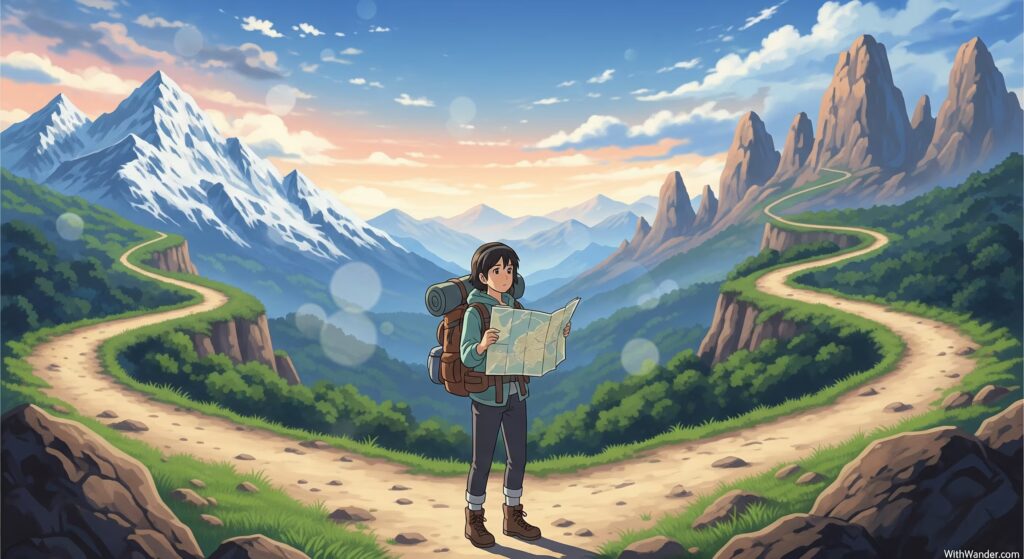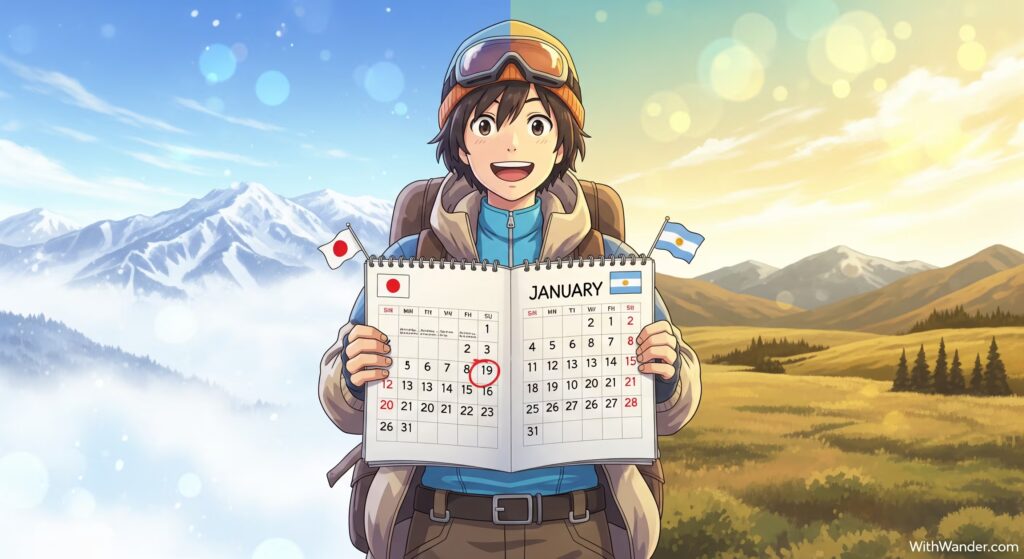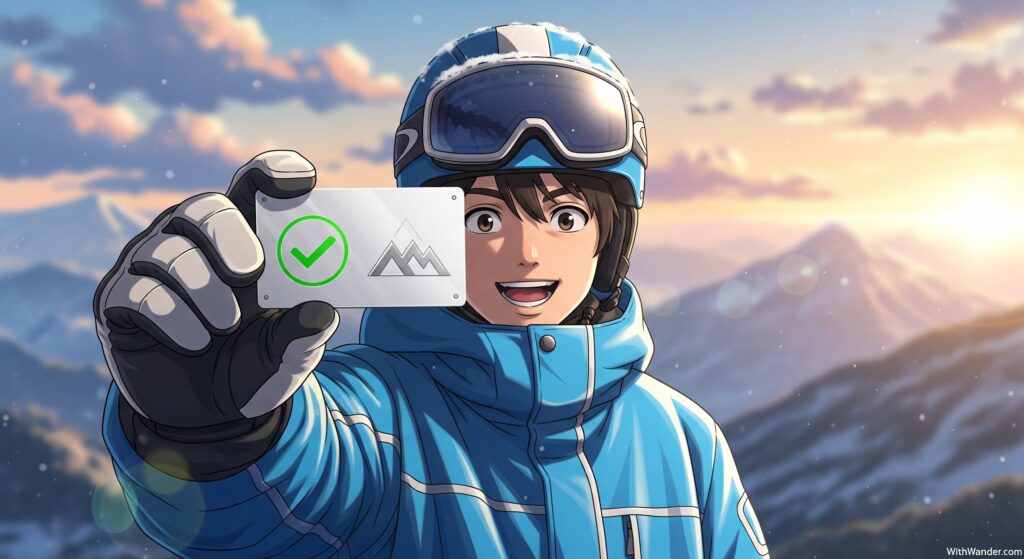INDEX
You’re at a crossroads, facing a choice between two of the planet’s most epic adventures.
On one hand, the legendary powder snow of Japan.
On the other, the granite spires and glacial lakes of Patagonia.
Deciding on your big niseko or patagonia trip is a fantastic problem to have, and I’ve been in your exact shoes.
I’ve carved through Niseko’s feather-light snow and I’ve hiked against the winds of Torres del Paine.
This guide cuts through the noise.
We’ll compare the costs, the social scenes, the timing, and the logistics to help you choose the right once-in-a-lifetime experience for you.
Deciding Your Niseko or Patagonia Trip: Key Factors

Your first step is to match the destination to your travel style.
Are you seeking the thrill of speed and a lively social scene, or the quiet reward of a long-distance trek?
This first filter is the most important one.
Niseko is a bustling international ski resort with a vibrant après-ski life.
You’ll find bars, restaurants, and a very social atmosphere.
Patagonia’s W Trek is about disconnecting on the trail with fellow hikers.
Evenings are quiet, spent in communal mountain lodges (refugios).
Niseko’s famous powder (Japow!) is best from late December to February.
This is peak season, so expect it to be busy and more expensive.
Patagonia’s hiking season runs from November to March, their summer.
This is when weather is most stable and days are longest.
Skiing in Niseko demands strong legs and ski/snowboard fitness.
You can ski at your own pace, but deep powder is a workout!
The W Trek requires solid hiking endurance for 4-5 days straight.
You’ll be covering 10-20 km daily with a pack, often with steep climbs.
The Vibe Check: Social Scene & Atmosphere

The feeling of a place is just as important as the activity.
Niseko and Patagonia could not be more different in this regard.
One is a high-energy hub, the other is a peaceful wilderness escape.
🍻Niseko, Japan: The International Powder Party
Niseko feels like a global ski village dropped into Hokkaido. English is everywhere, the food options are diverse, and the après-ski scene is a big part of the experience. You go from epic powder runs straight to a lively izakaya or bar. It’s social, energetic, and very accessible for international travelers. Payment is now seamless with widespread contactless acceptance throughout the resort.
⛺Patagonia, Chile: The Hiker’s Camaraderie
The W Trek fosters a unique bond among hikers. You’ll meet people from all over the world on the trail and share stories over simple dinners in the refugios. The vibe is quiet, respectful of nature, and focused on the shared experience of the trek. It’s about early nights and early mornings, not late-night parties.
Budget Breakdown: Patagonia W Trek vs Japan Skiing Costs

Let’s talk money.
Both are premium trips, but the costs break down differently.
Japan’s biggest expenses are lift passes and accommodation, while Patagonia’s are park entry and the logistics of the trek itself.
Here is a look at what I experienced for a week-long trip, not including international flights.
Breakdown: Accommodation is the big variable. A shared lodge might be $120/night, while a ski-in-ski-out condo can be $600+. Lift passes are around $70/day (¥8,400 for adults). Food and drinks can add up quickly in the resort area, but contactless payments now make transactions seamless.
Breakdown: Booking guided treks or pre-booking refugios with full board is the main cost (around $1200-$2100). Add park entry fees ($50 USD for foreigners staying 3+ days via pasesparques.cl), bus transfers from Puerto Natales, and gear rental. Eating in town before/after is cheaper than in Niseko.
When to Go: January Skiing Niseko vs Hiking Patagonia

January is a prime month for both destinations, but it offers very different experiences.
You’re choosing between the heart of winter and the peak of summer.
January is peak “Japow” season, with legendary snowfalls.
It’s the absolute best time for deep, light powder skiing.
In Patagonia, January means long summer days and the best chance of clear weather.
All trails, ferries, and services are fully operational.
Niseko is extremely crowded and expensive in January.
Book flights and accommodation many months in advance.
Patagonia also sees peak crowds and prices; book refugios a year out if possible.
The famous Patagonian wind can be at its strongest in summer.
The Food Scene: Is Niseko Good for Vegetarians?

Food is a huge part of travel for me.
The good news is that both destinations can work for plant-based eaters, but one requires a bit more planning.
So, is niseko good for vegetarians?
Yes, surprisingly so for Japan!
Because it’s such an international hub, many restaurants in the main Hirafu village have dedicated vegetarian menus or are happy to adapt dishes.
You’ll find veggie ramen, soups, and more. QR code menus are now common, making it easier to translate options.
In Patagonia, options on the trail are more limited.
Refugio meals are typically set menus, but they always offer a vegetarian option if you notify them when booking.
It’s often pasta or rice-based, simple but filling.
💡Vegetarian Pro-Tip
For Niseko, learn the phrase “Watashi wa bejitarian desu” and about dashi (fish stock), which can be in seemingly veggie dishes. For Patagonia, pack extra high-energy vegetarian snacks like nuts and protein bars, as the trail options can get repetitive.
Passes & Perks: Using Ikon Pass in Niseko Japan

If you’re a serious skier, you might already have a multi-resort pass.
This can be a major factor in your decision.
For those wondering about using Ikon Pass in Niseko Japan, it’s a fantastic perk.
The Ikon Pass grants you 7 days at Niseko United for full pass holders (5 days for Base Pass holders), which covers all four interlinked resorts (Grand Hirafu, Hanazono, Niseko Village, Annupuri).
You can now scan your pass directly at lift gates or visit a ticket window with your pass and ID to get your lift tickets.
This saves a significant amount of money (over $490 USD for a week based on 2025-26 pricing) and makes Niseko an even more attractive option if you already have the pass.
The resort now features QR code ticket machines and contactless payment systems throughout.
Patagonia doesn’t have an equivalent pass system.
Access is managed by the national park authorities through Chile’s official park system.
You pay a one-time park entrance fee online in advance and then book your accommodation (refugios or campsites) separately or as part of a tour package.
FAQs: Your Questions on a Niseko or Patagonia Trip

How difficult is the W Trek in Patagonia?
It’s challenging but achievable for anyone with good hiking fitness.
The main difficulties are the daily distances (up to 22km) and the unpredictable, often very strong, winds.
The terrain itself is on well-maintained trails.
Do I need to speak Japanese or Spanish?
In Niseko, you can easily get by with only English. It’s a very international resort with QR code menus for easy translation.
In Patagonia, knowing some basic Spanish is extremely helpful and appreciated, especially in towns like Puerto Natales.
On the trek, guides and refugio staff usually speak English.
Is Niseko or Patagonia better for solo travelers?
Both are great.
Niseko is very social, and it’s easy to meet people in ski groups, chairlifts, and at après-ski bars.
Patagonia’s W Trek has a strong sense of community, and you’ll find many solo travelers to connect with in the refugios.
What’s the biggest hidden cost for each trip?
For Niseko, it’s the cost of food and drinks in the resort. A simple dinner can easily cost $35-$50 USD.
For Patagonia, it’s the gear.
If you don’t own good quality waterproof hiking gear, the cost of buying or renting it can add up significantly.
How far in advance do I need to book everything?
For Patagonia, you should book your refugios on the W Trek up to a year in advance, as they fill up extremely quickly for the 2025-2026 season.
For Niseko during the peak January season, booking flights and your preferred accommodation at least six to nine months ahead is essential.
I’m a vegetarian; which destination is easier for food?
Niseko is surprisingly easier for vegetarians.
As a global resort, many restaurants have dedicated veggie options and QR code menus for easy translation.
Patagonia requires more planning; you must notify the refugios that you need a vegetarian meal when you book, and I recommend packing your own high-energy snacks.
What kind of fitness is required for each trip?
Niseko requires good ski or snowboard fitness, especially core and leg strength for navigating deep powder.
The W Trek in Patagonia demands hiking endurance.
You need to be comfortable hiking for 4-8 hours a day for several consecutive days while carrying a pack.
Can I just show up in Niseko with my Ikon Pass?
Almost.
With the 2025-26 season, many lifts now scan Ikon passes directly at gates.
If you need a physical pass, take your Ikon Pass and photo ID to any Niseko United ticket window.
They will issue you a keycard for the number of days included with your pass (7 days for full pass, 5 for base).
Which trip is better if I’m on a tighter budget?
Patagonia can be done more cheaply than Niseko if you camp and cook your own food.
The main costs for the W Trek are pre-booked, and food in towns like Puerto Natales is affordable.
In Niseko, the daily costs… can add up very quickly.
